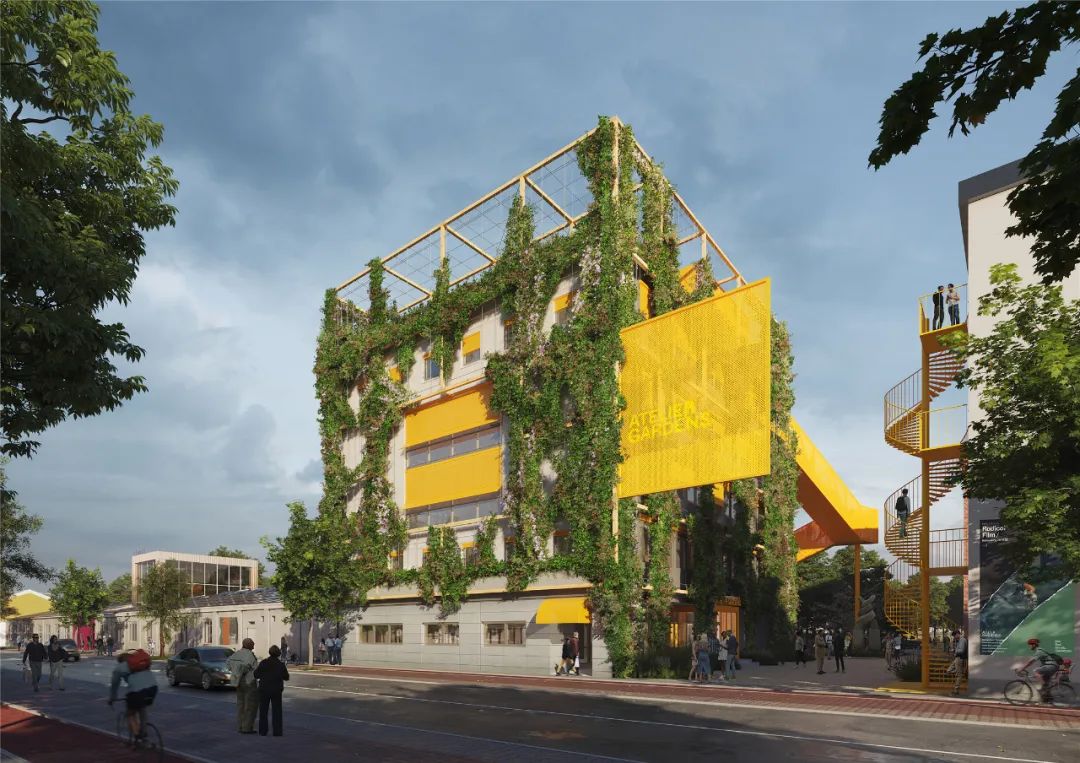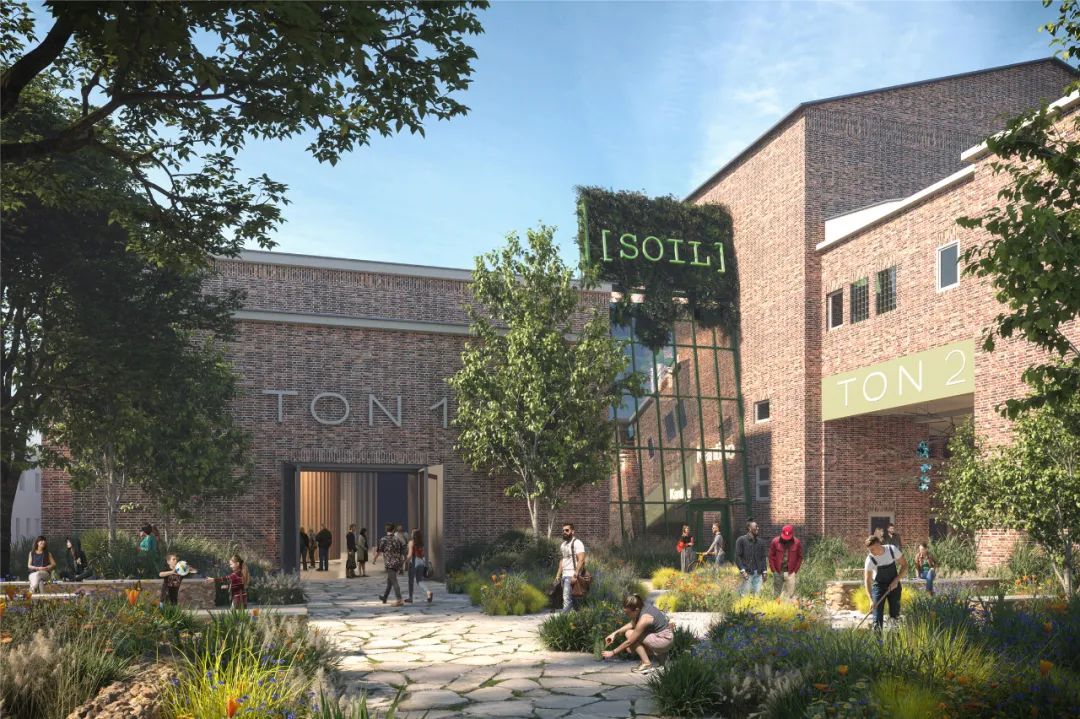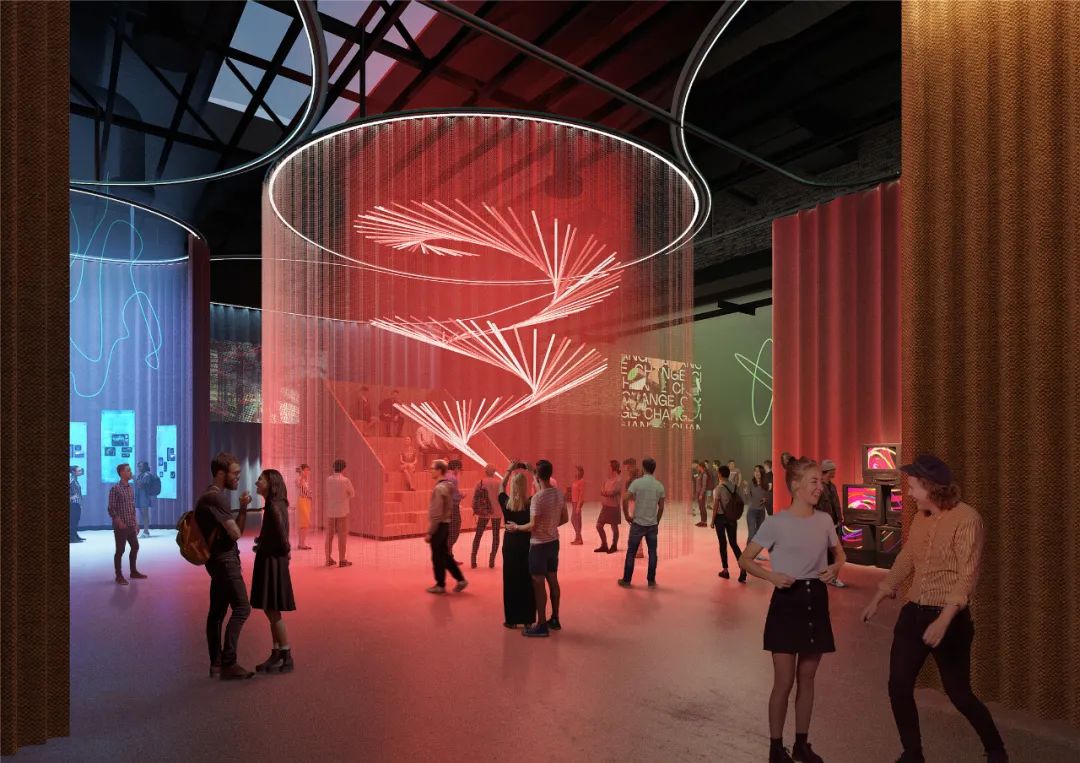
△ 效果图 ©MVRDV
MVRDV已经获得了Atelier Gardens的前两栋建筑的规划批准,将以可持续性的方式,改造柏林联合电影工作室(BUFA)园区。
MVRDV has received planning approval for the first two buildings in Atelier Gardens, a proposal to sustainably transform the campus of Berliner Union Film Ateliers (BUFA).
BUFA位于柏林Tempelhof机场的南部边缘,自其第一批建筑在一个多世纪前建成以来,一直是柏林电影和电视业的重要组成部分。现在,BUFA的用户群正从电影制作人扩展到所有类型的“变革者”,包括关注行动主义和社会正义的组织和个人——这是由其物理空间身份的改变所催化的。
Situated on the southern edge of Berlin’s Tempelhof Airport, BUFA has been a key part of Berlin’s film and television industry since its first buildings were constructed over a century ago. Now, BUFA is expanding its user base beyond filmmakers to encompass all forms of ‘change makers’, including organisations and individuals with a focus on activism and social justice – catalysed by a change of identity in its physical spaces.

△ 效果图 ©MVRDV
五个摄影工作室和各种配套设施构成了一个密集的园区:富有魅力的大型砖建筑界定了狭窄的小巷和开放的广场。设计保留并增强了这种空间多样性,一系列可持续性的改造,利用现有的结构进行更新,同时最大限度地发挥空间间隙的潜力,而不是一味地拆除、重建。
The five filming studios and assortment of ancillary facilities form a dense campus: large, charismatic brick buildings define narrow alleys and open plazas. MVRDV’s design preserves and enhances this spatial diversity: a series of sustainable transformations, which take advantage of the existing structures rather than demolishing and rebuilding, refresh the buildings while maximising the potential of the spaces between.

△ 效果图 ©MVRDV
园区将以生态景观为中心进行改造,移除大面积的铺路,减少车辆,增加屋顶花园和绿色广场的透水性和生物多样性。其他可持续性措施也被纳入其中,如生态厕所、雨水收集和水循环利用。自然通风也可得到改善。目前正在考虑的另一项设计是,将从拆除两个旧仓库中回收的钢材直接在现场再利用,搭建一个新的入口展馆。
The campus will be transformed with an ecologically focused landscape: large areas of paving are removed, eliminating vehicles and adding water permeability and biodiversity with rooftop gardens and green plazas. Other sustainability measures are also incorporated, such as eco-toilets, rainwater collection and water recycling, and improved natural ventilation. Another proposal currently under consideration would see steel salvaged from the demolition of two outdated warehouses reused directly on site to create a new entrance pavilion.

△ 效果图 ©MVRDV
23,800平方米的园区总体规划采用了增量发展的方法进行更新,认为每个建筑的改造都是对过往的回应。第一个开发项目最近获得了建筑审批,为主入口旁边的建筑改造,即1号屋以及1号工作室的改造。
The masterplan for the 23,800m2 campus takes an incremental approach to refresh the film studios, considering each building transformation as a response to the previous ones. The first of these developments, which have recently received construction approval, are the transformation of the building next to the main entrance known as House 1, and the renovation of Studio 1.

△ 效果图 ©MVRDV
Studio 1已有将近100年的历史,对于现代电影制作而言有些过时,近年主要用于电视制作和商业广告。它也是被列入保护名录的建筑,这就需要建筑师在不以任何显著方式、永久地改变建筑现有特征的情况下,创造一个满足不同需求的灵活空间。设计需要延长建筑的寿命,以确保园区的可持续未来,同时也尊重其历史。
At almost 100 years old, Studio 1 is somewhat outdated for modern film production, being used most in recent years for television productions and commercials. It is also a listed building, which necessitated a design that creates a flexible space for a variety of uses without permanently altering the existing features of the building in any significant way. The design needed to lengthen the lifespan of the building to ensure a sustainable future for the campus while also respecting its history.
设计通过“低技术改造”实现了这一点,它的特色在于应用了复杂的幕布导轨,并使其有别于大部分类似场景的隐藏状态,使其成为了空间的焦点。导轨上安装了各种明亮颜色的幕布,从树莓色到蜂蜜黄色,用以划分空间。幕布也有不同的功能,如隔音幕布、半透明幕布。
MVRDV’s design achieves this through a “low tech transformation” with one stand-out feature: an intricate overhead curtain rail that – unlike in most film studios where curtain rails are hidden – becomes a focal point of the space. The rail supports a variety of curtains in a range of bright colours, from raspberry to honey yellow, that can be used to divide the space, each with different functions (such as acoustic curtains and translucent curtains).

△ 效果图 ©MVRDV
通过这种方式,新增建筑与原建筑形成对比,空间灵活而非固定,色彩丰富而非黑色。砖墙仍然可见,而导轨上方增加的天窗使空间更适合于不同的用途。建筑的其他功能也进行了更新,包括新的室内墙面表面、更有效的通风系统。
In this way, the new additions contrast the original building: flexible instead of fixed, and colourful instead of black. Brick walls are kept visible, while above the curtain rail, a skylight is added in the roof of the building to make the space more suitable for different uses. Other features of the building are updated, with new interior surfaces and a new more efficient ventilation system.


△ 效果图 ©MVRDV
最初建于1997年的1号住宅的改造则更为激进。该建筑的室内气候不佳,夏天过热,墙壁隔热效果很差。改造后,木质框架和攀缘植物的绿色“包装”,用最少的材料提供最大的影响。框架延伸到屋顶之上,形成一个受保护的花园和屋顶凉亭,从建筑本身和直接通向屋顶的锯齿形楼梯都可以进入。
The transformation of House 1, which was originally built in 1997, is more radical. The building has a poor indoor climate, with overheating in summer and poorly insulated walls. It is made more efficient by a green “wrap”, created with a wooden frame and climbing plants, delivering maximum impact with minimal material. This frame extends above the roofline to form a sheltered garden and rooftop pavilion, accessible from both the building itself and a zig-zagging staircase that leads directly to the rooftop.
建筑室内将容纳灵活的工作空间、咖啡吧和会议空间,同样希望用最少的新材料实现最大的性能改进。
Inside, the building will host flexible workspaces, a café-bar, and meeting spaces, with a similar goal of achieving maximum performance improvement with minimal new material.

△ 效果图 ©MVRDV
完整项目信息
Facts
Project Name: Atelier Gardens
Location: Berlin, Germany
Year: 2021
Client: Fabrix
Size and Programme: 23,800m2 – Studios, Auditoriums, Offices
Credits
Architect: MVRDV
Founding Partner in charge: Jacob van Rijs
Partner: Fokke Moerel
Director: Enno Zuidema
Design Team: Klaas Hofman, Jonathan Schuster, Monica di Salvo, Pim Bangert, Brygida Zawadzka, Daniella Persson, Chiara Tomassi, Andre Bahremand, Emilie Koch, Alexandra Farmazon, Stijn Lanters, Mathias Pudelko, Alexandru Mitea
Visualisations: Antonio Luca Coco, Pavlos Ventouris, Angelo La Delfa, Luca Piattelli, Francesco Vitale, Jaroslaw Jeda, Luana La Martina, Lorenzo D’Alessandro, Gianlorenzo Petrini, Stefania Trozzi
Images: ©MVRDV
Copyright: MVRDV 2021 – (Winy Maas, Jacob van Rijs, Nathalie de Vries, Frans de Witte, Fokke Moerel, Wenchian Shi, Jan Knikker, Stefan de Koning, Bertrand Schippan)
Partners:
Landscape Design: Harris Bugg Studio
Co-architect: HS-Architekten
本文由MVRDV授权有方编辑发布。欢迎转发,禁止以有方版本转载。
上一篇:讲座直播预告:曲面的自由与理性 | “强结构”系列讲座05、06介绍
下一篇:AnA × 有方|伊东丰雄